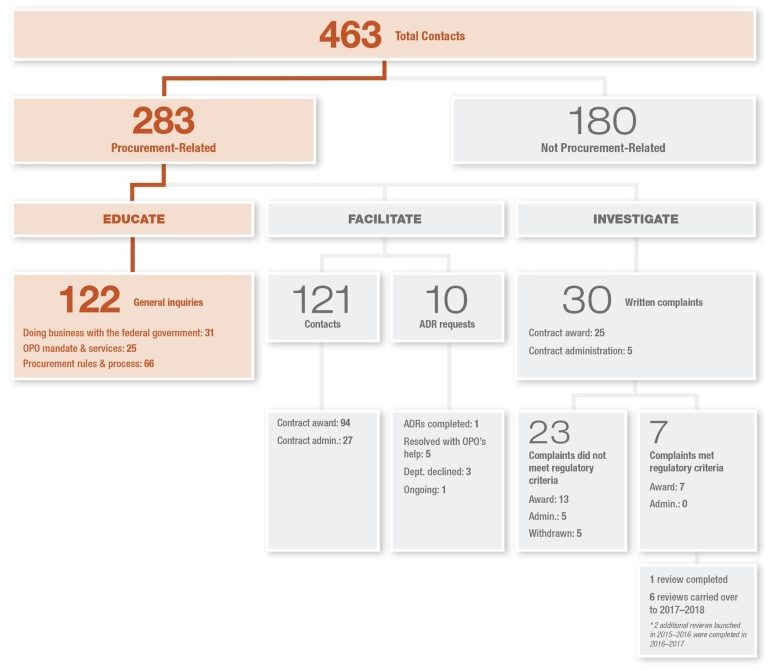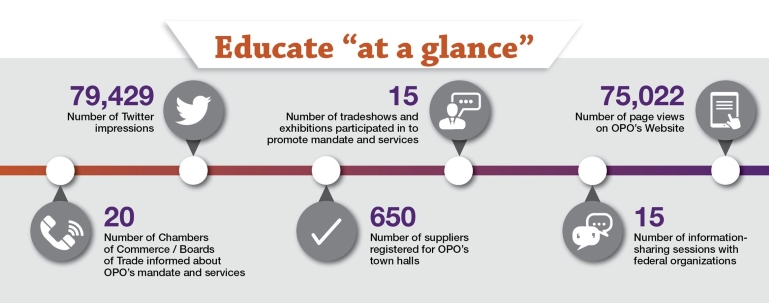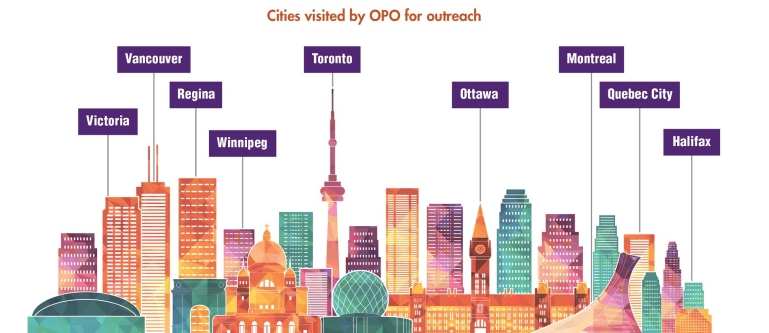Educate: Office of the Procurement Ombudsman Annual Report 2016-2017
"Our team found the presentation very informative this morning." - Town hall participant

Image description
This diagram emphasizes that of the 283 procurement-related contacts, 122 were determined to fall within the Office's Educate pillar. This number is further divided into contacts looking to do business with the federal government (31), information about OPO's mandate and services (25), and procurement rules and practices. (66)
OPO uses the Educate pillar to engage with a variety of individuals who operate in the federal procurement environment. These individuals most commonly represent small and medium-sized businesses (that is suppliers) selling, or hoping to sell, goods or services to federal organizations. Federal officials involved in procurement (that is procurement specialists, program managers and federal organizations’ senior management) also form important stakeholder groups for OPO.
Much like a two-way street, OPO uses the Educate pillar to both inform individuals about the Office’s mandate and services, relevant procurement rules and good procurement practices, and be informed of the opportunities and challenges experienced by suppliers and officials involved in federal procurement.
What OPO did to respond to inquiries and requests for information
Whether contacted by telephone, email, letter, fax, social media, website or face-to-face, OPO sought to provide meaningful information in a timely, professional and courteous manner. Of the 283 procurement-related contacts received in 2016–2017, 122 (43%) contacts were addressed by providing information and responding to inquiries. These contacts included questions and inquiries related to:
- how to do business with the federal government;
- OPO's mandate and services; and
- federal procurement rules and processes, including how to obtain security clearances and how to find information on the Buyandsell.gc.ca website.
The remaining 161 procurement related contacts were addressed through the Facilitate and Investigate pillars and are described in subsequent sections of this report.
What OPO did to raise awareness and share information
In addition to addressing contacts to the Office, OPO participated in 60 outreach events across the country in 2016–2017. These consisted of town hall-style meetings with suppliers and information-sharing sessions with federal organizations arranged by the Office. OPO representatives also attended select conferences and tradeshows to speak with suppliers and federal officials. These events allowed the Office to share information with suppliers, procurement specialists and program managers to foster a greater understanding of procurement, and procurement-related issues or concerns, among all stakeholders. It also allowed the Office to collect information on the views of these groups regarding federal procurement.

Image description
This diagram outlines the methods in which OPO educates citizens on their mandate and services. During the 2016-2017 fiscal year, OPO had 79,429 Twitter impressions and 75,022 page views on OPO's website. 650 suppliers registered for OPO's town halls, and 20 Chambers of Commerce/Boards of Trade were informed about OPO's mandate and services. OPO also participated in 15 tradeshows & exhibitions and 15 information sharing sessions with federal organizations.

Image description
This diagram outlines the cities that have been visited by OPO for outreach. These cities include Victoria, Vancouver, Regina, Winnipeg, Toronto, Ottawa, Montréal, Québec City and Halifax.
What OPO heard
The following are examples of what the Office heard from suppliers and federal officials during outreach events in 2016–2017:
Shared issues between suppliers and federal officials
Problematic procurement process: The procurement process is administratively heavy, complex and lacks flexibility. Standardization and simplifying procurement tools, to the extent possible, could alleviate the complexity and burden of producing solicitations (for procurement officers and program managers) and responding to solicitations (for suppliers).
To debrief or not to debrief: Suppliers have raised concerns that debriefs by federal officials often lack the substance and clarity needed to understand decisions made and allow suppliers to improve future bids. On the other hand, federal officials have stated that debriefs are time consuming and may be unnecessary when goods or services are purchased using a lowest price selection and that some suppliers are not interested in learning about the shortfalls of their bids but rather seek to argue decisions.
A heavy burden to bear: Liability clauses and mandatory insurance requirements add risks and costs to suppliers, which may decrease the number of businesses willing to compete for federal contracts. In addition, the need for suppliers to secure insurance may delay the start of contracts and negatively impact delivery dates. Mandatory insurance requirements should only be used in instances where there is a clearly defined need.
Cumbersome clearances: While some improvements have been made, obtaining security clearances for contractors is a process that remains costly, time-consuming, complicated and cumbersome.
Suppliers
Is it worth it?: It takes a significant investment of time and resources to respond to federal solicitations, even for low dollar-value contracts. This situation is further exacerbated when dealing with standing offers or supply arrangements given there is no guarantee of work even if a supplier qualifies on these tools.
Restrained by requirements: National delivery requirements and bundling of multiple goods or services under one solicitation limit opportunities for small and medium-sized Canadian businesses. These requirements act as barriers to bidding on federal contracts given these businesses do not possess the capital or resources required to satisfy such requirements.
Playing by the same rules: Subcontractors believe the same rules concerning fairness, openness and transparency should apply to prime contractors when awarding subcontracts since they are funded by taxpayer money.
Fear of blacklisting: Suppliers are concerned that raising issues with federal organizations will result in them being blacklisted and prevented from participating in future contracting opportunities.
Unauthorized usage: Suppliers have expressed frustration when federal organizations consult them in order to receive industry specific input for their planning. Some suppliers are concerned federal organizations use their “ideas” to better define their requirements and then award contracts to competitors. Some suppliers are also concerned that intellectual property (for example engineering drawings) requested as part of a solicitation may be shared with the competitor that has been awarded the contract.
Procurement Specialists
Feeling forgotten: There are no government-wide recruitment and development programs for procurement specialists. Many federal organizations are too small or short-staffed to create internal programs and are looking for centralized leadership to provide government wide programs.
Experience is essential: There are limited experienced procurement specialists to staff key positions. As there is no centralized approach to ensure common levels of experience and knowledge across federal organizations in the procurement community, procurement specialists at the same level could have vastly different levels of experience across different federal organizations.
Senior management support: Procurement specialists reported positive client relationships when there is senior management support for procurement. Conversely, reports of poor client relationships occurred where procurement specialists discussed a lack of support or buy-in from their senior management team, as procurement did not seem to be a priority. In addition, procurement specialists indicated senior management support is beneficial in encouraging program managers to learn more about the complexity and timelines associated with procurement processes, which helps avoid issues when planning projects.
Time to sharpen the tools: Procurement tools (i.e. standing offers and supply arrangements) for mandatory goods or services (for example furniture) can sometimes be cumbersome and complicated to use, especially for low dollar value contracts. In addition, there is variation in the rules associated with each tool, which raises potential risks of confusion.
An aging threshold: Federal organizations are allowed to direct a contract to a supplier if the value of the contract is less than $25,000. This amount was adopted in the 1980s and has not increased since, despite the loss of purchasing power over the years.
Program Managers
Nowhere to turn: Program managers in some federal organizations feel unsupported as the number of procurement specialists in their organization is limited, resulting in little to no help available to provide guidance on procurement.
Poor performers: Poor performing suppliers continue to obtain federal contracts as vendor performance measures seem to be largely non existent or ineffective in most organizations.
The long and winding road: The procurement process takes too long and requires too many senior level decisions or approvals, which further slows the process.
Getting things right: Some program managers have identified the benefits and success of involving their procurement team before they intend to purchase goods or services so as to incorporate procurement timelines in their project planning and avoid issues.
Sharing success: Since many organizations purchase the same goods and services, effective practices should be shared across federal organizations. This would be beneficial for those who are not experts in the field of procurement.
OPO's outreach activities not only provided the Office with an opportunity to collect the views of those involved in federal procurement, they also allowed representatives from the Office to raise awareness of OPO's mandate and services, including how OPO can help facilitate the resolution of procurement-related issues or disputes.
- Date modified: